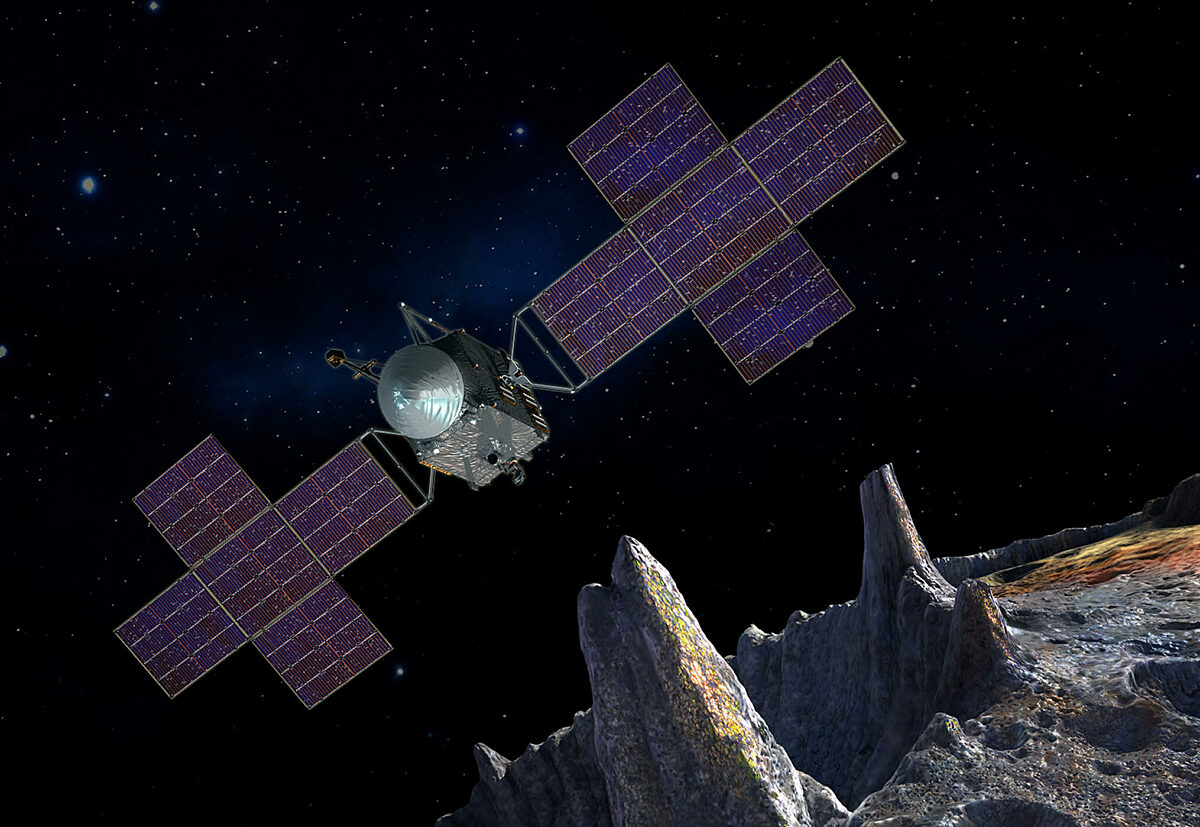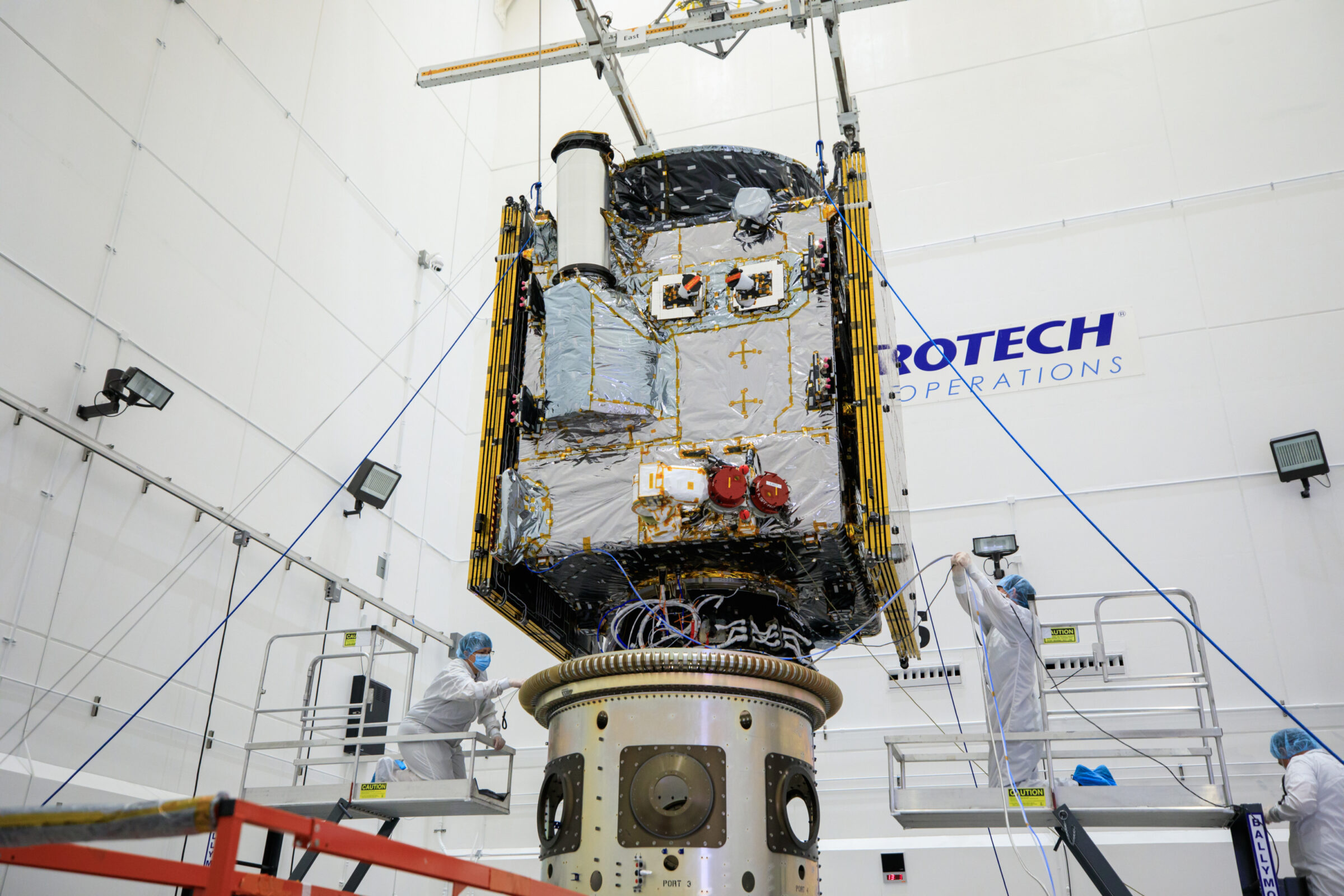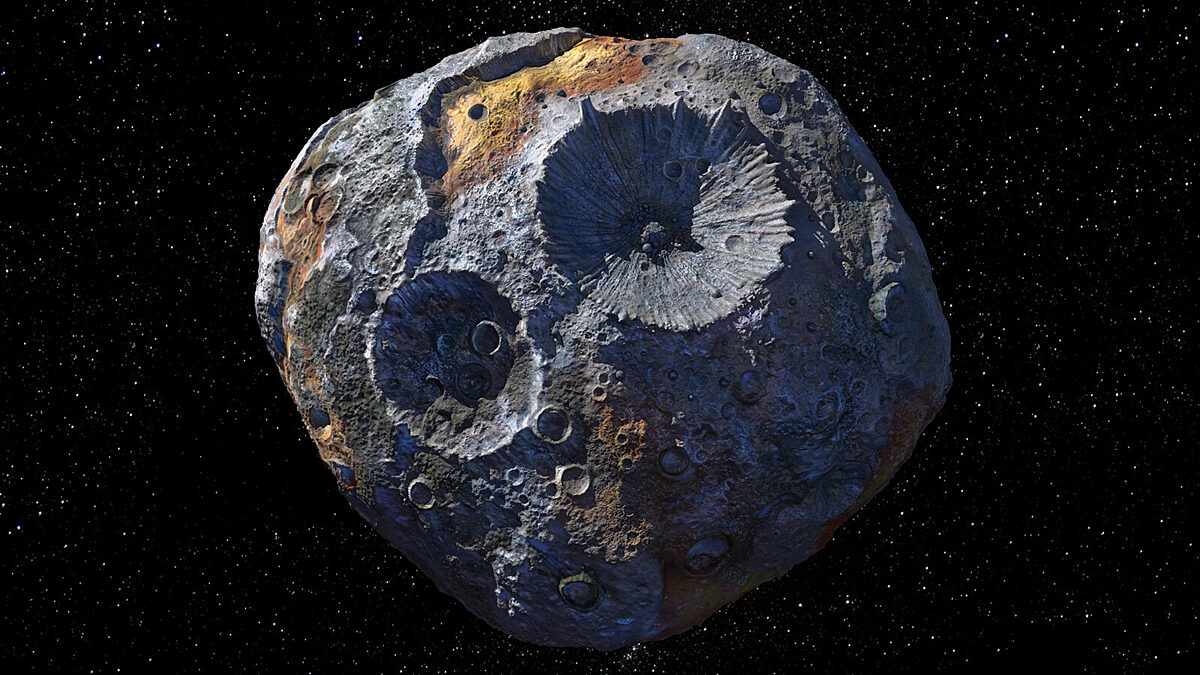Psyche, exploring a metal world
NASA’s mission to study a relic from the birth of our solar system
Highlights
- Psyche will be the first mission ever to a metal-rich asteroid.
- Its target, also named Psyche, could be the exposed core of a would-be planet, or a core that was smashed and reformed, or an asteroid affected by a special kind of volcanism. Solving this puzzle will help us understand how planets like Earth are born.
- The mission launched in 2023 and will begin orbiting its target, the asteroid 16 Psyche, in August 2029.
Why is NASA sending a mission to asteroid Psyche?
Every asteroid we’ve explored so far has been made of rock or ice. But metal-rich asteroids are also powerful windows into the Solar System’s past, and perhaps none is as mysterious as the asteroid 16 Psyche. Some scientists think that Psyche is the exposed core of a would-be planet, but other ideas have also become popular. No matter what, Psyche is unique: it is the most massive metal-rich asteroid in the Solar System.
The idea that Psyche is the remains of a would-be planet was not always as debated. We know that when the rocky planets of the Solar System — Earth, Mercury, Venus, and Mars — formed about 4.6 billion years ago, they did so violently. Thousands of would-be planets larger than 100 kilometers (62 miles) collided with each other and gradually consolidated to form the large terrestrial planets we know today. Psyche, which is 210 kilometers (130 miles) wide, could be a leftover that survived.
According to this explanation, Psyche was disrupted when another early almost-planet (or multiple) smashed into it, ripping off its outer rocky layers and exposing its metallic core.

On the other hand, it’s also possible that these impacts completely disrupted Psyche so that it coalesced into a well-mixed combination of rock and metal. In that case, Psyche would not be the core of a would-be planet, but it would be descended from one. But it’s also possible that Psyche does not have that lineage at all, and instead gets its metal from iron volcanism. In that case, it may be more similar to other giant asteroids that have been visited by spacecraft in the past, like Ceres, than previously thought.
NASA’s Psyche spacecraft will help settle this debate. The mission launched from NASA’s Kennedy Space Center in October 2023 and will perform a gravity assist flyby of Mars to reach the asteroid Psyche in the main asteroid belt in 2029. There, it will orbit the asteroid and systematically study it, mapping its surface, measuring its chemical makeup, and looking for signs of volcanism. Whatever it finds, the science mission will help us better understand planet formation and bring us one step closer to understanding how we got here.

How will the spacecraft study Psyche?
The Psyche spacecraft hosts a number of instruments that it will use to study its target asteroid after arriving in 2029. It carries the Multispectral Imager, a pair of high-resolution cameras with filters to map the asteroid’s composition of metal and rock. The spacecraft will also use its Gamma-Ray and Neutron Spectrometer (GRNS) to help identify specific elements in metals and in any rocks on Psyche.
Together, the multispectral imager and GRNS will look for hints of volcanic vents and volcanic materials on Psyche’s surface. And based on how much iron and nickel the spacecraft detects on or just below Psyche’s surface, we’ll know how likely the asteroid is to be an exposed protoplanetary core. Scientists will also be able to use the elemental composition of the surface to tell if its rocks were part of the collision-ripped mantle on top of Psyche’s early core or were simply delivered by later asteroid impacts.
The spacecraft will also measure Psyche’s gravity field. As the spacecraft passes over denser regions of Psyche, its position and velocity will be impacted by the changes in gravity. The radio communications instrument onboard will note these finer movements of the spacecraft, allowing scientists to infer Psyche’s gravity field and peek into its interior. This is how we’ll know if Psyche is a dense whole body reminiscent of a core or a rubble pile like many asteroids.
If data from these three instruments tell us that Psyche’s rocks are thoroughly mixed with metals, it’s likely not a core and is instead a leftover body from the Solar System’s birth just like asteroids and comets. However, if Psyche has large swaths of rocks in it, they might be leftover slabs from the lost mantle.
In any case, if Psyche was a liquid iron core, it might have churned to produce a strong magnetic field like Earth’s core. While Psyche isn’t expected to have a magnetic field today, the once strong field might have imprinted its magnetic signatures in Psyche’s rocks and metals. Another of the Psyche spacecraft’s instruments, a magnetometer, will measure such remnant magnetic fields on Psyche, which would be good evidence for it being a protoplanetary core.
Finally, NASA’s Psyche mission also hosts a laser communications system that allows it to transmit 10 to 100 times more data than traditional radio systems. This laser system, called Deep Space Optical Communications (DSOC), is one of two technological innovations on the Psyche spacecraft that NASA hopes to use in future missions. The second is an electric propulsion system: the spacecraft’s thrusters are powered by its solar arrays, as opposed to chemical reactions. Psyche marks the first time this technology has been used beyond the Moon.

Who is leading the Psyche mission?
Arizona State University leads the Psyche mission and its science investigation, while NASA’s Jet Propulsion Laboratory (JPL) manages the mission and is in charge of operations and navigation. Maxar Technologies, Inc. built the spacecraft itself and a variety of organizations contributed its instruments. JPL also handled the mission’s flight software. The principal investigator for the mission is Lindy Elkins-Tanton, a foundation and regents professor in the School of Earth and Space Exploration at Arizona State University.
Creating craters of metal
To get an idea of what craters would look like on Psyche, scientists created little metallic craters of their own. At NASA’s Ames Vertical Gun Range facility, technicians shot small, spherical iron-nickel meteorites — yes, the real deal — on metal blocks at various angles with high velocities up to 7 kilometers per second (about 16,000 miles per hour) to mimic impacts on Psyche. This gave scientists insights into how craters would form very differently on metallic worlds compared to rocky ones; they should expect Psyche’s craters to have rugged interiors and razor-sharp rims, for example.
How much does Psyche cost?
The Psyche mission will cost approximately $961 million over 12 years. But that's not the whole story.
Support missions like Psyche
Whether it's advocating, teaching, inspiring, or learning, you can do something for space, right now. Let's get to work.
Acknowledgments: this page was initially written by Jatan Mehta in 2021. It was updated by Asa Stahl in 2024.


 Explore Worlds
Explore Worlds Find Life
Find Life Defend Earth
Defend Earth




